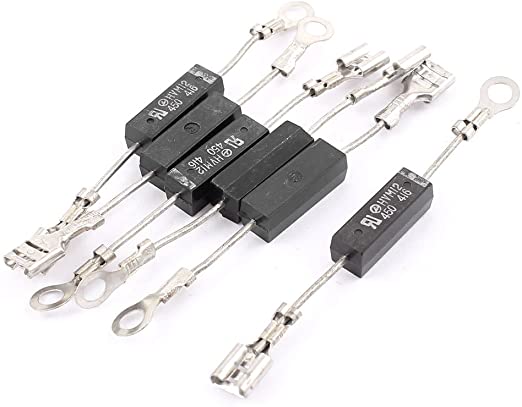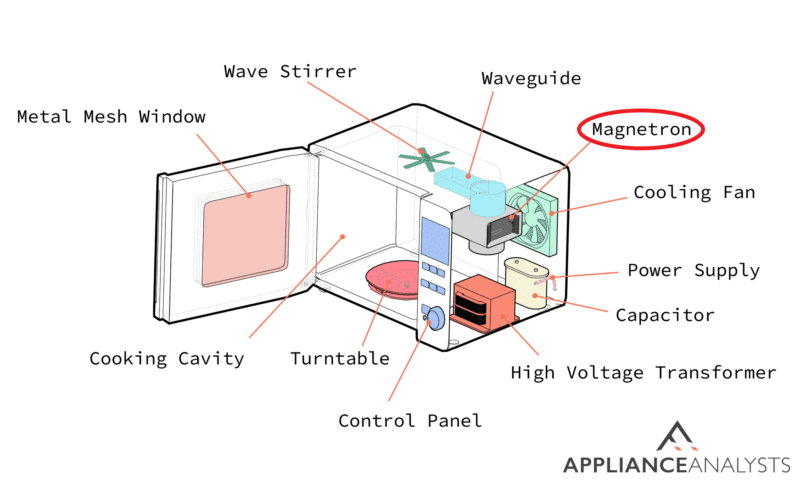Microwaves are such an amazing invention.
We may take them for granted – but I try to always appreciate them. Instant popcorn? Simple cooking? Dinner from frozen to piping hot in minutes? Incredible!
But what the heck do you do when your microwave is not heating?
All of a sudden your microwave dinner becomes an unhealthy takeout and an expensive visit from a technician. Well, not necessarily.
Let me walk you through some potential explanations. But first, a quick summary:
If your microwave is not heating, first check it’s not because of a setting (timer, low power). Switch on/off and test again with water. If it’s still not heating, common issues are door frame switches, high-voltage diode, or the microwave’s magnetron. If you’re not qualified, check with a professional.
Now, as with any technology issue…
Make Sure You’re Not Overlooking Something Simple
We’ve all been there.
Oh man! The oven’s totally busted! It’s not working at all! Wait…
*CLICK*
….It was just turned off at the wall. Whoops.
There’s some easy mistakes that can stop a microwave from working. Ensure that you’ve not:
- Set a timer. Modern microwaves often have timer settings, so you can have food waiting when you arrive home. Make sure you’ve not just told it to cook in 5 hours time.
- Used the wrong setting/mode. Check that you’ve not just set it to the lowest possible power. Or that you’re trying to reheat a full frozen meal while it’s on a ‘keep warm’ setting.
- Put something that can’t be microwaved. It’s a common mistake to think a microwave ‘heats’ everything. Instead, they heat the water inside food. If you’ve tried to microwave dry food, it likely won’t have an effect. Test with some liquid to find out.
Checked all those? Microwave still not working? Okay, then it’s disclaimer time.
Disclaimer
The following contains information about the inner workings and parts of a microwave. Reading this article does not make you an expert on microwaves or microwave repair.
While we take them for granted, microwaves are one of the most dangerous appliances in any modern home. Do not underestimate them. Even when unplugged, the high voltage capacitor can still hold enough power to kill someone.
Why trust us? This article was written by Craig Anderson and James Blackford.
Craig has helped thousands of other homeowners repair their appliances since 2016.
James is one of our resident appliance experts, with over 16 years of experience. He currently works as a Master Technician for SquareTrade, and runs his own appliance repair business.
Prefer to Listen?
If you prefer video or audio, here’s me and James talking about a microwave that doesn’t heat your food for the ApplianceAnalysts Podcast:
Why Your Microwave Isn’t Heating
Like any other appliance, a broken microwave must be diagnosed component by component.
For those unfamiliar (or need a refresher) on taking apart a microwave, here’s a great video that walks through step-by-step:
Onto the components.
I’ve listed the components in rough order of commonality.
Before we get started, please note that any time I recommend removing the case – make sure you disconnect the microwave completely from power first. Then discharge the high-voltage capacitor before continuing. Again, if you don’t know how to do that, please don’t try to wing it!
High-Voltage Diode
The first reason why your microwave is likely not heating is that you have a bad high-voltage diode. High-voltage diodes are key in converting your A/C power supply into D/C power for the Magnetron. If the diode is malfunctioning (or already has), you’ll likely have heard a buzzing or humming sound.

When inspecting it, it’s usually obvious if it’s burnt out!
Diodes can go bad over time or due to a bad magnetron. High-voltage diodes are simple but delicate (and cheap) parts that are easy to replace. [Again: do not try if you’re not qualified to].
Diagnosis
High-voltage diodes can be tested with a multimeter and a 9v battery. Multimeters channel electricity in one direction and should have a higher resistance on one end with a lower resistance on the other. If you find continuity with both sides, the diode is no longer doing what it should.
My usual advice when microwave high-voltage diodes go bad is to buy replacements. High-voltage diode replacements for most microwaves are easy to find and typically go for as little as $20 on online marketplaces.
Once you replace the diodes, try testing the microwave again – ideally, it should be working normally again. But if the microwave is still not warming food, please keep reading, as many more components could be to blame.
Magnetron
Your Magnetron is your microwave, as it’s the component that produces the microwave radiation that heats your food. So if the Magnetron fails, it would make sense that your microwave is not heating.
Magnetrons use a TON of power, and any malfunction quickly blows a fuse.

Diagnosis
The fuses can be tested with a multimeter and should display a resistance of around 2–3 ohms. If that’s fine, move one of the multimeter probes onto the metal casing. The multimeter shouldn’t display zero – if it does, something isn’t right.
If the fuse has blown, replacing the fuse isn’t a good solution. The root problem will still lie unaddressed.
You’ll likely need a new magnetron, and you’ll certainly need someone who can install it properly for you. If the Magnetron has been replaced and your microwave is still not heating, you’re likely looking for a different faulty component.
High Voltage Capacitor / Transformer
Another possible explanation for why your microwave is not heating is a High-voltage capacitor failure.
High-voltage capacitors work with the high-voltage diode to power the Magnetron. These capacitors are some of the most complex parts to replace. And, unless your microwave is brand new and high-end, it’s probably worth considering a new microwave entirely.
Diagnosis
If it’s the transformer that’s gone, it will likely have arced (like in the movies) and produce a pretty offputting smell.
The signs of a bad high-voltage capacitor and transformer are definitely noticeable, especially if you’re in the same room as the microwave when the fault happens!
Door Switches
The humble door switch, if failing, could explain why your microwave is not heating. Since microwaves produce electromagnetic waves, the door must remain closed during cooking.
Door switch failure is more likely to occur on older microwaves or those that often get slammed shut.
You can quickly check this by closing the microwave door and seeing if the light stays on. If so, the door switch isn’t sending the proper signal to the rest of the appliance.
In high-end microwaves, there are sometimes 3 or even 4-door switch detectors. And it only takes one failure to shut down the entire machine!
Diagnosis
First up, DON’T just try slamming the door harder! You’ll only cause more damage!
Instead, carefully but firmly close the door and re-check. If the door opens with a mechanical button, try pushing the button down firmly as you close the door, then release it when it’s closed.
Still no good? Then the switch is probably donezo. If you take the case off, we can check the terminals of the switch with a multimeter. Push down the switch to simulate the door being closed, and both terminals should have continuity (the read zero when tested). If you need a replacement, it must come from your manufacturer, as each brand differs.
Thermal Fuse / Thermal Protector
Microwaves, like many other appliances, have overheating protection, generally in the form of fuses that blow.
If your microwave is not heating, chances are your thermal fuse has blown, in which case, the best solution is to replace the fuse. And while replacing your microwave’s thermal fuse is fairly simple, the fuses themselves are not nearly as common as those in your home fuse box, so you’ll need to get the specific parts from a manufacturer.
To be sure about the condition of the fuse, check the mag and do a continuity test. If the multimeter reads zero, the fuse is likely the reason your microwave is not heating.
If you want to get any replacement part – or see how much one would cost – click to enter your model number in the search bar below. Our partners at AppliancePartsPros stock almost every part with free guides on how to install them.

Control Board
If your microwave’s control board is faulty, it’s doubtful the microwave will even turn on, and it would easily explain why your microwave is not heating. Replacing the control board is often simple but not cheap. In my opinion, if your microwave is under $110, I recommend buying a new appliance altogether, as the control board is typically within that price range.
Unless your microwave is brand new, it’s worth considering a replacement.
How Does A Microwave Work?
Microwaves first came about in the 1940s. When an American scientist noticed his radar equipment had melted the candy bar in his pocket.
Microwaves have since revolutionized kitchens worldwide – but how do they work?
Actually, it’s fairly simple!
Every microwave contains a magnetron, which produces high-frequency radiowaves. Or ‘microwaves’. The process is similar to how radios and wifi work via waves in the air (which we can’t see).
The Magnetron’s waves are directed by a waveguide into the microwave’s internal compartment. The waves bounce around like crazy in there – especially when they come into contact with water, and have just the right frequency to be absorbed by water, making the liquid’s molecules vibrate, which raises its temperature.
Since microwaves only agitate water particles, it makes sense that some materials, and entirely dry objects, are unaffected by them, and it’s also why microwaves are so dangerous to humans – since we’re over 70% water.
Now, how does a Magnetron work?
Great question! But sadly, it’s a little beyond my ability to explain it well. Instead, here’s the best guide I’ve found to the physics behind magnetrons.
Conclusion
Microwaves have become an integral part of our lives. So, when our trusty microwaves break, it can throw a real wrench into our plans for the day.
I hope this guide has helped give you a few things to try if your microwave is not heating. Again, please do not try anything you’re not confident or qualified to do. I often tell homeowners it’s better to call someone and pay a little extra than hurt themselves trying to address their appliance issues.
If this content has helped you, please consider supporting us by checking out some of our related articles below and subscribing to our newsletter.
Thank you for taking the time to read this. I hope you have a fantastic day/evening!
-Craig.







